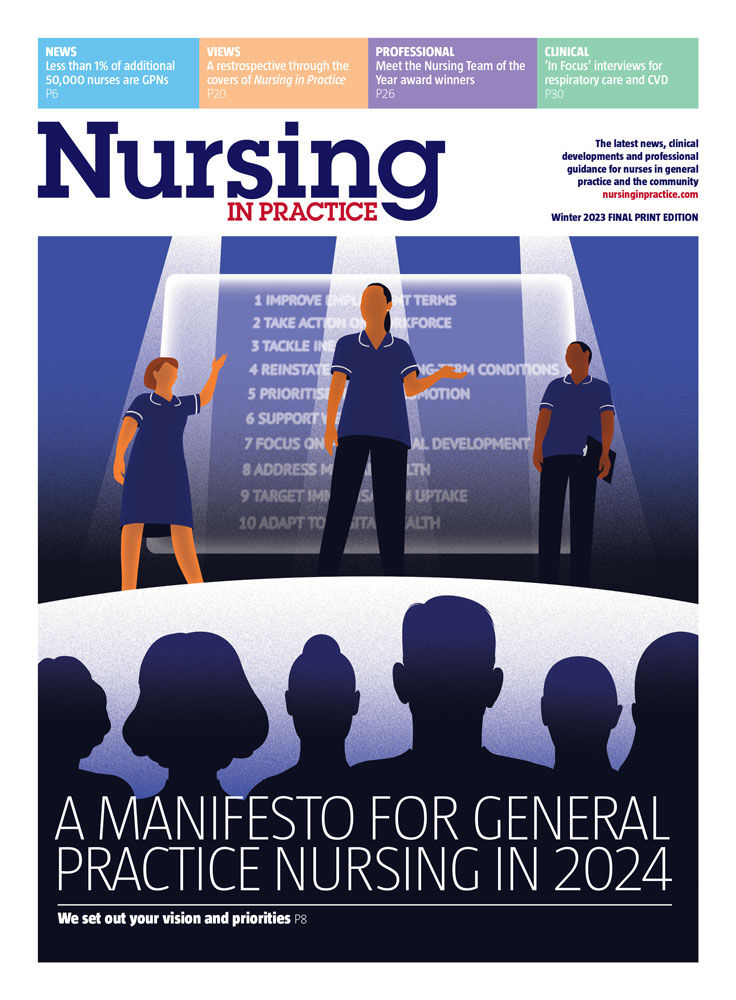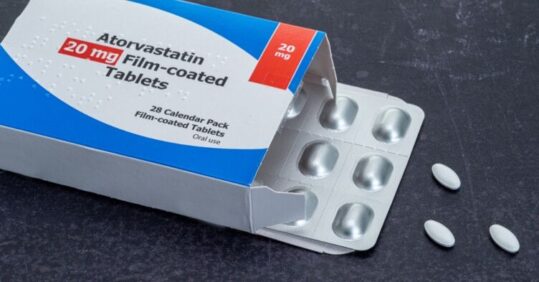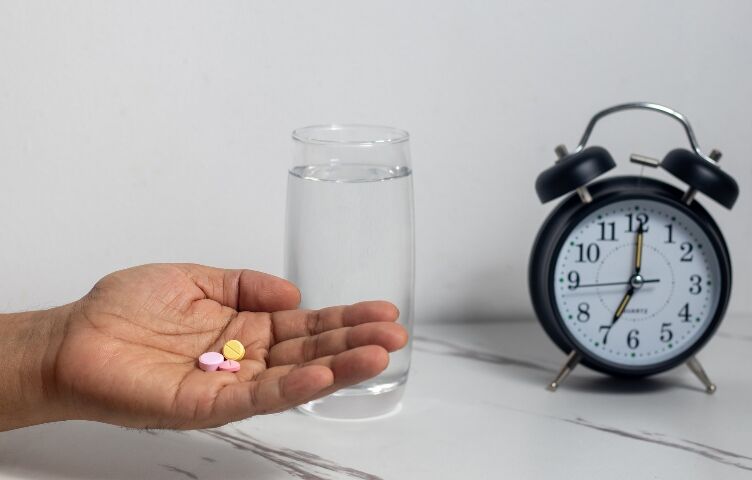Cardiovascular nurse specialist Michaela Nuttall explains why patients may be reluctant to take statins and how nurses can best support them to keep taking their statin where possible
Statins remain the cornerstone for the prevention and treatment of cardiovascular disease (CVD), with substantial evidence that they reduce morbidity and mortality.1 In clinical trials, statins are broadly well tolerated (often with a similar adverse effect profile to placebo). However, this is not seen in clinical practice, where 40% to 75% of patients have been reported to discontinue statin treatment within two years because of side effects.2 Yet, stopping statin therapy is associated with an increased risk of major CVD events; alongside this, there is concern that clinicians are labelling patients as ‘statin intolerant’ too quickly. This is also impacted by negative media coverage, which has been linked to statin discontinuation.
What are the side effects of statins?
The most commonly reported adverse effects are muscle-related problems (eg, muscle pain, weakness, and/or fatigue), which can occur with or without creatinine kinase (CK) elevation (a marker of muscle tissue damage).
However, while it has been established that statins can cause muscle problems, they are much less common than people expect. Indeed, research has suggested that the true rate of statin-related muscle side effects is considerably lower than that reported by patients in clinical practice.
One large meta-analysis found that of all muscle side effects reported, only one in 15 was likely due to the statin. The researchers concluded that for more than 90% of people who reported muscle related problems, the statin was not the cause.3
The discrepancy between drop-out rates seen in ‘real-life’ practice compared with the low side effect rates seen in clinical trials has been attributed to the so-called ‘nocebo’ effect. This is where patients experience side effects because of their expectations, rather than the drug itself. It is thought that simply having information about possible side effects raises people’s likelihood of experiencing these effects.
One study, funded by the British Heart Foundation, demonstrated that patients were just as likely to report side effects with a placebo pill as with a statin; 90 per cent of the side effects people reported when they took a daily statin were also experienced when they unknowingly took a daily placebo pill, in keeping with the nocebo effect.4
The issue is thought to be partly due to some exaggeration of side effects in the mainstream and social media. This expectation of side effects can also lead to ‘statin reluctance’, an attitudinal state of aversion to taking statins (often without prior exposure).
There are also some less obvious reasons patients say they do not want to take statins – as evidenced by discussions on social media. Some comments I have seen recently around why people should avoid statins include:
- Patients advising that ‘herbal statins’ are safer than the ones prescribed by doctors.
- Suspicion that the new community pharmacist role in primary care is about profit rather than improving patient outcomes.
- Beliefs that statin prescribing by GPs is only about chasing QOF points.
- Concerns that statins give people diabetes.
Sometimes what we perceive to be the issue is not what’s on the patient’s mind. It is important for nurses to be aware of the potential concerns and be prepared for these, in order to offer appropriate support and advice.
Starting patients on a statin
Statins are usually prescribed for secondary prevention of CVD in patients with established CVD, for example those who have had a heart attack (myocardial infarction [MI]) or stroke; and for primary prevention of CVD in patients without established CVD but with risk factors such as a QRISK3 score >10%.5
When discussing the offer to take a statin, patients will often raise the following questions:
- Why do I need them?
- I don’t have any symptoms – so what does the treatment do, and how do I know it’s working?
- Statins cause side effects, don’t they – how do I know they’re safe?
- How long is the course of medication? If my cholesterol goes down, can I stop?
It is well recognised that shared decision making can improve patient concordance with treatment, leading to better outcomes. This is a collaborative process that involves a person and their healthcare professional working together to reach a joint decision about care.
The NICE lipid guidelines decision aid can be very useful for discussing statins for primary prevention, ie, with patients who have not had a previous MI or stroke but are considered at relatively high risk of such CVD events. It explores the advantages and disadvantages of taking a statin, including the risk of developing diabetes, helping to ensure that the patient makes a decision that is right for them.6
For example, when discussing the potential side effect of muscle pain, the tool provides a simple diagram and clearly describes how, on average, for every 100 people who take a statin:
- about 72 people do not get muscle pain;
- about 26 people get muscle pain, but would have done if they had not taken a statin;
- about two people get muscle pain because they took a statin.
Similarly it provides a simple diagram describing the risk of diabetes: on average for every 100 people who take a statin:
- about 96 people will not get diabetes;
- about four people will get diabetes whether they took a statin or not;
- about one person will get diabetes as result of taking the statin.
Using the tool helps nurses to have a balanced discussion of the risks and benefits and allows patients to make an informed decision to take a statin.
However, note that NICE is very clear this decision aid is not suitable for discussing statins for secondary prevention of CVD – ie, when offering statins to people with established CVD, such as those who have had MI or stroke, in whom the benefits much more clearly outweigh any potential risks of adverse events. We must not leave such patients without lipid-lowering medication if possible. Where statins are contraindicated or not tolerated, alternative lipid-lowering therapy should be used.2
Why and how should nurses help patients stay on a statin?
Once a patient has agreed to take a statin, we need them to keep taking it. For people with long-term conditions, it is widely accepted that only 50% take medication the way intended (judged to be when patients take at least 80% of the prescribed doses).7
In terms of statin adherence, one study found that among patients taking statins for secondary prevention after a CVD event such as MI, adherence to treatment ranged from 57% to 84% (depending on the intensity of treatment) at year 1, dropping to 48% to 72% by year 6.8 The same study showed adherence was linked to better outcomes – relative to no treatment, those who were adherent to their treatment had a 35% reduced relative risk of another CVD event, compared with only a 12% reduction in risk among those who were classed as nonadherent (failing to take at least 80% of their medication).
A similar, albeit less stark, pattern was seen for patients on statin treatment for primary prevention. For example, in patients with diabetes but without CVD, adherence to treatment was 60-75% (depending on treatment intensity) at 1 year, falling to around 55-65% at year 6, and adherent patients had a roughly 26% reduction in relative risk of CVD events compared with a 15% reduction in CVD risk in those who were classed nonadherent.8
The first few weeks and months may be key when people start taking medication for a long-term condition. One study showed that 30% of people stop taking medication at 10 days after initiation and a further 30% do so at 30 days.9 Currently, there is no systematic approach to address this, but nurses may be able to build in follow-up appointments or calls in the first month. Note also that NICE recommends liver function tests are done 2-3 months after initiation so this can be a good opportunity to ask how patients are getting on with their medication and offer support and advice.
Responding to reports of side effects
Patients presenting with side effects should not be dismissed as experiencing the nocebo effect nor assumed to be statin intolerant. The NHS England Statin Intolerance Pathway provides clear guidance on how to explore and manage side effects and potential statin intolerance in a safe and evidence-based way.10
It encourages us to consider statin reluctance, the nocebo effect, and whether the patient has statin-associated muscle symptoms (SAMS) or non-statin-related musculoskeletal symptoms (non-SRM; see Table 1).
Table 1. Key definitions for statin side effects
| Statin intolerance | NICE defines intolerance to initial statin therapy as the presence of clinically significant adverse effects that represent an unacceptable risk to the patient or that may reduce compliance with therapy.1 |
| Adverse event | An event that is considered unacceptable by the patient and/or some laboratory abnormalities, both attributed to statin treatment and leading to its discontinuation. |
| Statin-associated muscle symptoms (SAMS)
|
The main reason for statin non-adherence and/or discontinuation. However, should not automatically lead to a label of ‘statin intolerance’. They may not be due to statin-related muscle toxicity (SRM), which can be excluded by stopping and restarting the statin. |
| Non-statin-related musculoskeletal symptoms (Non-SRM)
|
Symptoms that are not typical of SRM (eg, asymmetric distribution, failure to resolve with de-challenge despite normal CK). Consider other metabolic, degenerative, or inflammatory musculoskeletal disorders, eg, vitamin D deficiency, polymyalgia rheumatica. It is important to check the bone profile, vitamin D, and levels of the inflammatory marker c-reactive protein (CRP). |
In practice, not all nurses will deal directly with statin intolerance or side effects. However, they will frequently see these patients for other reasons. It is important to be aware of the guidance and management pathway, rather than automatically assuming that any symptoms a patient reports are true side effects and that the patient is intolerant. Some patients will find symptoms are tolerable in the long run, especially if they are aware of the benefits of taking the statin.
The pathway recommends a stepwise approach to a patient presenting with side effects. The main steps can be summarised as follows:
- If it’s unclear the side effects are really due to the statin, explore the potential nocebo effect or statin reluctance, as well as any other potential causes such as drug interactions. At this stage it is really important to listen to the patient’s concerns and go through the benefits and risks of statins thoroughly. If non-muscle related, another cause should be explored (such as vitamin D deficiency).
- If it does seem the side effects are due to SRM, but symptoms are tolerable, the patient can continue on a statin provided their CK levels are acceptable, for 6 weeks, before being reassessed. If their symptoms do not improve, they should then be managed as for intolerable symptoms (see next step).
- Patients with intolerable SRM should have their statin stopped for 4-6 weeks. Then if symptoms resolve, the patient can be reintroduced to a lower dose or an alternative statin and gradually titrated to a higher dose to achieve appropriate lipid reductions. If symptoms recur, other lipid-lowering treatment options can be tried.
- Patients with moderately elevated CK will need to have their renal function checked before continuing with any further statin treatment. Patients with SRM who are found to have renal problems or very high CK levels require urgent specialist assessment.
(See NHS England’s Statin intolerance pathway for full details.)
In summary, despite the overwhelming CVD benefits from taking statins, especially in secondary prevention, it can be a challenge to persuade patients to start and stay on these drugs. This is for a number of interwoven reasons, including patients’ perceptions, messages from healthcare professionals and media misinformation.
While most nurses are not directly involved in the prescribing and monitoring of statins, they do see these patients regularly in clinics. Awareness of the issues around perceptions of side effects and subsequent management is key to improving patient outcomes.
Primary care has never been so busy; it is easy to see how patients can slip through the gaps. However, we have the potential tools to change attitudes and practice to ensure that statins are prescribed and taken correctly.
Michaela Nuttall is a nurse specialist in cardiovascular medicine
References
- NICE. Cardiovascular disease: risk assessment and reduction, including lipid modification. [NG28] 2023
- Toth P et al. Management of statin intolerance in 2018: still more questions than answers. Am J Cardiovasc Drugs 2018; 18(3):157-73
- Cholesterol Treatment Trialists Collaboration. Effect of statin therapy on muscle symptoms: an individual participant data meta-analysis of large-scale, randomised, double-blind trials. Lancet 2022; 400(10355):832-45
- Wood F et al. N-of-1 trial of a statin, placebo, or no treatment to assess side effects. N Engl J Med2020;383:2182-2184
- NHS England. Summary of national guidance for lipid management. Last updated April 2024
- NICE. Cardiovascular disease: risk assessment and reduction, including lipid modification. Tools and resources: Patient decision aid on should I take a statin? May 2023
- Brown M et al. Medication adherence: WHO cares? Mayo Clin Proc2011; 86(4):304-14
- Khunti K et al. Association of a combined measure of adherence and treatment intensity with cardiovascular outcomes in patients with atherosclerosis or other cardiovascular risk factors treated with statins and/or ezetimibe. JAMA Netw Open 2018;1(8):e185554
- Barber et al. Patients’ problems with new medication for chronic conditions. BMJ Qual Saf Health Care 2004;13:172-5
- NHS England. Statin intolerance pathway. Last updated August 2023







